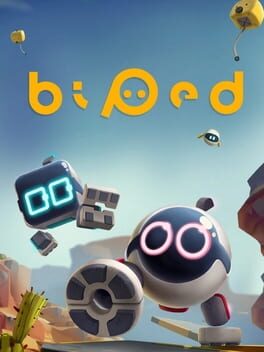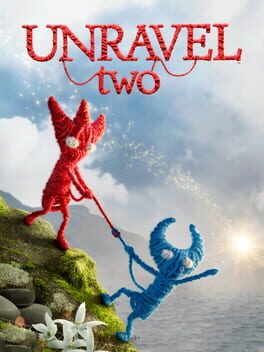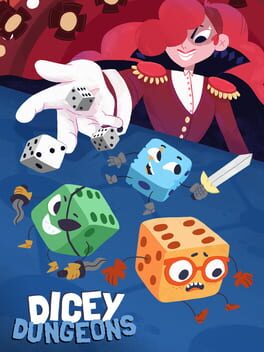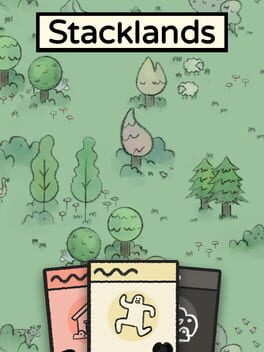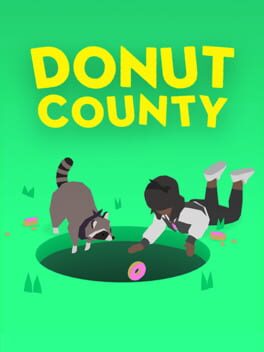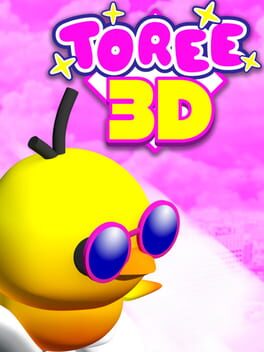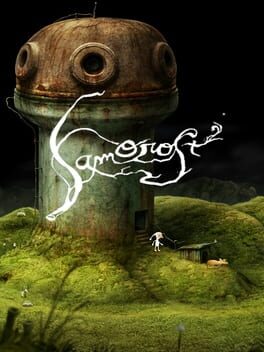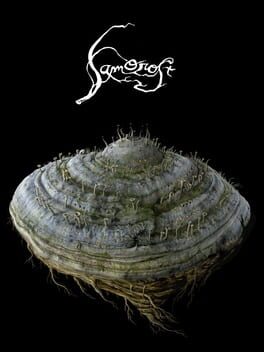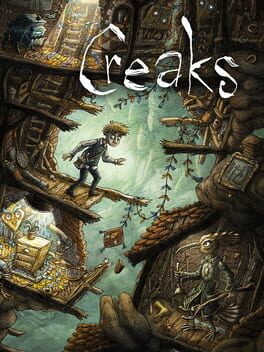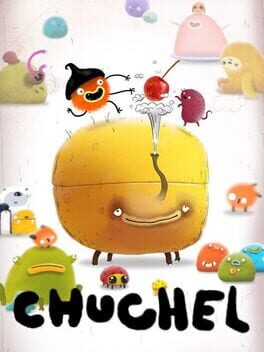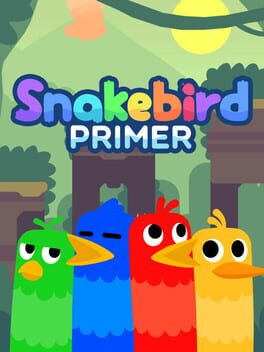hb_robo
2018
This review contains spoilers
Great platformer, mechanically and in its challenge design. Poor narrative vessel, especially in its character roster. It nails the pathos, though - the angst, the self-loathing driven by the awareness of the angst, the lack of purpose, the fixation, the stubbornness, the perseverance. Pushing the player to great lengths in order to synchronize their achievement with Madeline's is genuinely quite inspired, but having to see Oshiro again in the epilogue takes the wind out of the sail.
2020
Axiomatic truth: give me little guys that are hard or unusual to control and I will give you a good review. Co-op is a natural extension of the chaos, forcing not only precision with your steps and grabs and lever pulls, but a coherent rhythm from both players.
Biped gets a lot of grief for its length, but I think it's fine to leave a nontraditional experience before it wears its welcome; what I jive less with is the lack of room to breathe and just play with the weird bodies you inhabit. Instead, the Biped equivalent of fidget spinners dot the landscape, hoping to distract you just long enough to mentally realign you back to the main objective. These impulses become obligatory, eventually more of a distraction, where a grander sense of imagination and whimsicality and freedom could have both soothed players after tough challenges and given them room to develop mastery of the bipedal movement.
Oh well, they can't all be Snake Pass, I guess.
Biped gets a lot of grief for its length, but I think it's fine to leave a nontraditional experience before it wears its welcome; what I jive less with is the lack of room to breathe and just play with the weird bodies you inhabit. Instead, the Biped equivalent of fidget spinners dot the landscape, hoping to distract you just long enough to mentally realign you back to the main objective. These impulses become obligatory, eventually more of a distraction, where a grander sense of imagination and whimsicality and freedom could have both soothed players after tough challenges and given them room to develop mastery of the bipedal movement.
Oh well, they can't all be Snake Pass, I guess.
2018
A B-grade co-op physics puzzler interspersed with C-grade pure platforming, tagged along by a complete mess of a narrative about... two friends doing things together? A horrifically ugly bloom-and-blur hyper-realistic art direction interweaves a pitifully morose score. The tutorial level in particular is so depressing that less than a third of a third of all Steam players make it to level 2. How unsurprising.
Unravel Two genuinely has its moments when it reveals its craft in the two-player puzzles, all of which revolve around using your conjoined tether in interesting ways, but it is woefully distracted by compulsive desires to become a Spectacle Game, one where the levels have all-caps meta subtitles and the story contains Dark Scenes. This effort lands so embarrassingly flat and abruptly that it hardly feels like anything happened at all. It sort of feels like the game version of Oscar bait, where every design decision is made to generate a murmuring respect from inexperienced eyes and not to actually achieve anything of merit.
To capstone your adventure, a credits sequence overflowing with insecurity begs the players to not come down so harshly by showing how cool and worker-friendly Coldwood Interactive is-- then, right on cue, a huge EA logo scrolls up the screen.
Unravel Two genuinely has its moments when it reveals its craft in the two-player puzzles, all of which revolve around using your conjoined tether in interesting ways, but it is woefully distracted by compulsive desires to become a Spectacle Game, one where the levels have all-caps meta subtitles and the story contains Dark Scenes. This effort lands so embarrassingly flat and abruptly that it hardly feels like anything happened at all. It sort of feels like the game version of Oscar bait, where every design decision is made to generate a murmuring respect from inexperienced eyes and not to actually achieve anything of merit.
To capstone your adventure, a credits sequence overflowing with insecurity begs the players to not come down so harshly by showing how cool and worker-friendly Coldwood Interactive is-- then, right on cue, a huge EA logo scrolls up the screen.
2012
Thomas Was Alone is a good reminder to let your cynicism be beaten down from time to time.
In the first two "worlds", I hated this game. It was dripping with misery, from the suicidal score to the torture chamber lighting to the nauseating Lost Vikings-esque repetition. Levels that neither communicated anything to the player or tested anything beyond patience. And all the while, a daft British voice is begging me to crack a smile at these silly, delusional little rectangles.
But by the final act, I was unconsciously accepting whatever premises were proposed. I'm told these two particular squares were dating, and from then on I tried not to separate them. This one is plotting something horrible, so I made him flake on the others whenever possible. This squat one is on an urgent quest to stop the evil fellow, so he moves with purpose. I found myself in a compelling position as both audience and storyteller... or a narrative conduit, perhaps.
It's bizarre to see a genre so unilaterally explored for ludic pleasure used as a narrative vessel. Still, it's undeniably interesting. What feels at first arbitrary reveals itself as purposeful, even if it never fully shakes its own flimsiness.
In the first two "worlds", I hated this game. It was dripping with misery, from the suicidal score to the torture chamber lighting to the nauseating Lost Vikings-esque repetition. Levels that neither communicated anything to the player or tested anything beyond patience. And all the while, a daft British voice is begging me to crack a smile at these silly, delusional little rectangles.
But by the final act, I was unconsciously accepting whatever premises were proposed. I'm told these two particular squares were dating, and from then on I tried not to separate them. This one is plotting something horrible, so I made him flake on the others whenever possible. This squat one is on an urgent quest to stop the evil fellow, so he moves with purpose. I found myself in a compelling position as both audience and storyteller... or a narrative conduit, perhaps.
It's bizarre to see a genre so unilaterally explored for ludic pleasure used as a narrative vessel. Still, it's undeniably interesting. What feels at first arbitrary reveals itself as purposeful, even if it never fully shakes its own flimsiness.
2019
I have come to realize that the roguelikes and roguelites that hold my attention are the ones that allow me time to make decisions but also leverage their randomness to make those decisions difficult, and not without risk. I like being rewarded for fast and loose critical thinking, and that level of comfort in relatively unstable environments. It helps me appreciate the breadth of the the domain that has been designed, the elegance of the interactions of simple mechanics, the organic subversion. Into the Breach was my previous muse in this style, and now Dicey Dungeons inhabits that space.
Above all, Cavanagh has absolutely nailed the core loop. It's a turn-based RPG dungeon-crawler with 15-20 minute runs that focuses on small numbers, where you are manipulate and utilize a "hand" of dice using a loadout of equipment cards -- activated by dice tribute -- that have value requirements or encourage certain strategies. Because of the inherent 1-6 limitations of dice as a player vehicle, there is a comforting return to low-numbers calculations - inflicting 10+ damage with a single action is a big deal. While a small detail, I think this lowering of number scale makes it easier to work out mental math and compare outcomes for alternate routes of a given turn. Each of the six playable characters cater to different playstyles, struggle with certain matchups or status ailments, and have unique pools of equipment drops that encourage specific kinds of dice interactions.
Best of all, all six have six episodes a piece, some of which completely alter their mechanics or equipment pools to further unsettle the player from any "groove". The best ones required consideration of meta-elements like enemy selection - in some cases, you may tack on an extra battle to save some Inventor gear for the boss, or maybe some simpler enemies become high-priority avoidances because the Jester will absorb their entire list of (bad) equipment as cards. I just can't get enough of how these simple challenges completely flip player strategies.
Even simple genre mainstays such as status conditions are handled in interesting ways. Burn damage lights a die ablaze, inflicting 2 damage if you choose to use it on your next turn, Freeze takes your highest-rolled dice and drops its value to 0, Shock will lock out a piece of gear unless you tribute a die to unlock it, and so on. This leads to some really amazing interactions, my favorite being that the Wizard's ice storm ability, which freezes every dice in your hand, unintentionally allows you to rig the Robot's blackjack-style dice drawing/rolling system, handing you consistent 1s until you hit the jackpot with no chance to bust.
My only serious gripe is one of balance in one specific type of episode, the "Elimination Rounds" which equip every enemy with upgraded gear, increasing damage taken considerably. While the actual challenge remains largely the same, the margin of error shrinks, and it becomes much more difficult to overcome the odds with quick thinking. In particular, the upgraded version of Buster, the most difficult final boss, can regularly do around 18 damage per turn, maxing out at 24 with 4 burns (which would do 2 damage a piece if you use the burned dice). Every time I saw him, no matter the character or loadout, was an instant loss. While the difficulty balance in the basic versions of the monsters is just about perfect, the upgraded kits can be a bit overkill.
Still, for a game that constantly teases you about being unlucky and against impossible odds, there are a hundred ways to succeed. This is the kind of game I am happy exists, the kind that feels "pure" in its design, and facilitates a wide variety of gamestates in such a short amount of time that it's difficult to ever truly be afflicted by the "going through the motions" illness so many roguelites spread. It may not have the stakes of Into the Breach, or the complexity of something like Slay the Spire, but Dicey Dungeons is a masterclass in design all its own.
Above all, Cavanagh has absolutely nailed the core loop. It's a turn-based RPG dungeon-crawler with 15-20 minute runs that focuses on small numbers, where you are manipulate and utilize a "hand" of dice using a loadout of equipment cards -- activated by dice tribute -- that have value requirements or encourage certain strategies. Because of the inherent 1-6 limitations of dice as a player vehicle, there is a comforting return to low-numbers calculations - inflicting 10+ damage with a single action is a big deal. While a small detail, I think this lowering of number scale makes it easier to work out mental math and compare outcomes for alternate routes of a given turn. Each of the six playable characters cater to different playstyles, struggle with certain matchups or status ailments, and have unique pools of equipment drops that encourage specific kinds of dice interactions.
Best of all, all six have six episodes a piece, some of which completely alter their mechanics or equipment pools to further unsettle the player from any "groove". The best ones required consideration of meta-elements like enemy selection - in some cases, you may tack on an extra battle to save some Inventor gear for the boss, or maybe some simpler enemies become high-priority avoidances because the Jester will absorb their entire list of (bad) equipment as cards. I just can't get enough of how these simple challenges completely flip player strategies.
Even simple genre mainstays such as status conditions are handled in interesting ways. Burn damage lights a die ablaze, inflicting 2 damage if you choose to use it on your next turn, Freeze takes your highest-rolled dice and drops its value to 0, Shock will lock out a piece of gear unless you tribute a die to unlock it, and so on. This leads to some really amazing interactions, my favorite being that the Wizard's ice storm ability, which freezes every dice in your hand, unintentionally allows you to rig the Robot's blackjack-style dice drawing/rolling system, handing you consistent 1s until you hit the jackpot with no chance to bust.
My only serious gripe is one of balance in one specific type of episode, the "Elimination Rounds" which equip every enemy with upgraded gear, increasing damage taken considerably. While the actual challenge remains largely the same, the margin of error shrinks, and it becomes much more difficult to overcome the odds with quick thinking. In particular, the upgraded version of Buster, the most difficult final boss, can regularly do around 18 damage per turn, maxing out at 24 with 4 burns (which would do 2 damage a piece if you use the burned dice). Every time I saw him, no matter the character or loadout, was an instant loss. While the difficulty balance in the basic versions of the monsters is just about perfect, the upgraded kits can be a bit overkill.
Still, for a game that constantly teases you about being unlucky and against impossible odds, there are a hundred ways to succeed. This is the kind of game I am happy exists, the kind that feels "pure" in its design, and facilitates a wide variety of gamestates in such a short amount of time that it's difficult to ever truly be afflicted by the "going through the motions" illness so many roguelites spread. It may not have the stakes of Into the Breach, or the complexity of something like Slay the Spire, but Dicey Dungeons is a masterclass in design all its own.
2022
On my first ever Stacklands run, a 15 minute endeavor, I died after foolishly charging my one remaining villager, a wooden-club wielding Warrior, through the first dark portal that appeared. "Oh, it's one of those games," I thought.
On my second run, with the new moons set to the longest speed, things couldn't have gone any differently. I received a plethora of lucky drops that led to quick innovations in industry. I spent turns churning out money over and over to try and see each card in each deck, build more things, finish more quests, gear up my growing legion of baddies. 3.5 hours later, I place the goblet on the Temple and clutch out a win against the "final boss" with 3 HP left on my final ninja. Ravaged of resources and needing to feed myself, I cashed out my entire board, bought a few dozen card packs, and eked out some more ideas before succumbing to the horde I summoned in my unboxing.
When I returned to Stacklands a couple of hours later, I suddenly felt deeply lost and confused. Having sped through the progression of the gamestate so quickly and thoroughly, I had not internalized much of anything. My massive list of recipes was organized in alphabetical order, and I could not recall what was important - or possible! - to create first. I had been dutifully fulfilling the list of new quests, and building new structures and recipes as the ideas appeared. Without the direction or feedback system, everything felt new again. I died of starvation on the second turn, having been unable to roll a Berry Bush from a booster pack.
I suppose I just need some more practice, but there is something to be said about how Stacklands approaches progression and information. I can't see what I'm able to build with 3 stone and 3 wood. I can't recreate the gamestate that guided me through the game's various building blocks in order of rough importance or value. The more you learn without internalizing, the more you have to re-learn on the next run. The longer you spend in the (significantly more stable, less intense) late game, the more foreign the (more turbulent, RNG-dependent) early game becomes.
Don't get me wrong, I'm going back. I just wish that I could get the feeling and flow of that second run back. I'm worried it won't reappear.
On my second run, with the new moons set to the longest speed, things couldn't have gone any differently. I received a plethora of lucky drops that led to quick innovations in industry. I spent turns churning out money over and over to try and see each card in each deck, build more things, finish more quests, gear up my growing legion of baddies. 3.5 hours later, I place the goblet on the Temple and clutch out a win against the "final boss" with 3 HP left on my final ninja. Ravaged of resources and needing to feed myself, I cashed out my entire board, bought a few dozen card packs, and eked out some more ideas before succumbing to the horde I summoned in my unboxing.
When I returned to Stacklands a couple of hours later, I suddenly felt deeply lost and confused. Having sped through the progression of the gamestate so quickly and thoroughly, I had not internalized much of anything. My massive list of recipes was organized in alphabetical order, and I could not recall what was important - or possible! - to create first. I had been dutifully fulfilling the list of new quests, and building new structures and recipes as the ideas appeared. Without the direction or feedback system, everything felt new again. I died of starvation on the second turn, having been unable to roll a Berry Bush from a booster pack.
I suppose I just need some more practice, but there is something to be said about how Stacklands approaches progression and information. I can't see what I'm able to build with 3 stone and 3 wood. I can't recreate the gamestate that guided me through the game's various building blocks in order of rough importance or value. The more you learn without internalizing, the more you have to re-learn on the next run. The longer you spend in the (significantly more stable, less intense) late game, the more foreign the (more turbulent, RNG-dependent) early game becomes.
Don't get me wrong, I'm going back. I just wish that I could get the feeling and flow of that second run back. I'm worried it won't reappear.
2018
A superbly-designed set of three-dimensional sokoban puzzles, wherein you must flip, turn, and nudge pipe parts into completed aquatic routes, while allowing your player character to still exit the vicinity without ruining anything. If I can nitpick, the arrangement of the puzzles does not follow a typical difficulty curve at all - in many cases the new mechanics and gimmicks introduced in the later stages (and more heavily featured in the "Hard" and "Expert" stages) were easier to comprehend than the basics of flipping and rotating those pipes in tight spaces.
Pipe Push Paradise also appears to be shooting for something a la A Good Snowman... with its closed-garden-open-world design, but outside of the very satisfying finale, it's not really explored. The strict tropexotica theming is also pretty passe, and talking to folks is usually completely uneventful. In general a feeling of progress beyond the completion ratio increasing was sorely lacking. My final solved puzzles before the (wonderful!) conclusion were in "worlds" 4 and 2 of 5, respectively.
These minor confusions compound to detract from an otherwise extremely challenging and rewarding traditional puzzler.
Pipe Push Paradise also appears to be shooting for something a la A Good Snowman... with its closed-garden-open-world design, but outside of the very satisfying finale, it's not really explored. The strict tropexotica theming is also pretty passe, and talking to folks is usually completely uneventful. In general a feeling of progress beyond the completion ratio increasing was sorely lacking. My final solved puzzles before the (wonderful!) conclusion were in "worlds" 4 and 2 of 5, respectively.
These minor confusions compound to detract from an otherwise extremely challenging and rewarding traditional puzzler.
2018
Donut County lives and dies with its hole. This game is inundated with comparisons to Katamari, but for good reason: both center around a near-unstoppable force of nature that defies basic reason, absorb everyday items to grow in strength, and have something to say about how much "stuff" really is around us all the time. Where Donut County really falls in comparison is in complexity and dynamics.
The hole has a fixed position relative to the environment, always at ground level, allowing it to slither underneath whatever it wants to ensnare. Its diameter grows a small fixed amount relative to the size of whatever it eats, until you eventually gobble the entire scene... or whatever you're allowed to within the restrictive walls of the diorama-like stages. If we disregard aesthetics, and think of the game arena mapped to a 2D plane, there are only three components at any given moment: the hole, things it can eat, and things it can't.
Katamari doesn't suffer from any of these problems; because it does not have a fixed position on the ground, you have to physically climb and reach the objects you wish to compile. The ball's diameter is not merely a polynomial growth but sprouts a wonderful, chaotic asymmetry as objects extend its hitbox with theirs. It is also allowed to roam free on wonderfully large environments where it can experience huge jumps in scale as it rampages through the world. Even if you gave the hole a sense of freedom like the Katamari receives, the player would quickly notice how the experience lacks the same difficulty and playfulness.
Esposito seems to have realized this during development, and took a very different approach by having the hole star as a narrative device. It is what is actually delivered by the local donut company instead of the expected pastry, and when enough folks lose their homes and band together underground, they wield the hole themselves to gather information on how to rescue everyone and put an end to the company causing the destruction. The enclosed stages are in fact the individual yards and fields and farms and campsites of each person's home - people with goals, loved ones, and motivations to get back above ground. The absurdity of the premise is appropriately met with comedic dialogue as the gang bickers about blame, game plans, and personal grievances.
Perhaps most notably, the hole also receives temporary power-ups and power-downs that restrict or enhance its ability to gulp its surroundings, whether it be a catapult that launches its most recent meal upwards as a projectile, or a pool of water to must find a way to drain. Sometimes it's a tentacle that you can use as a makeshift finger to operate machinery, or even some charcoal to light the whole hole ablaze. While these interactions are simple, they achieve two important things: solving the repetition of the basic hole loop, and allowing for a way to damage and be damaged by a surprise boss fight.
So what am I to make of this, a game that seems to have realized the problems with its own gameplay concept but managed to stylize and package its ideas so tidily? Is the lack of confidence in the hole worth castigation when it would have probably led to a worse final product? I'm not sure. I do know that the idea was worth exploring, the limitations were found, and significant effort was undertaken to create an interesting world, narrative thread, and cast of characters to compensate. Donut County may not change your life, but it's difficult to deny sheer competence.
The hole has a fixed position relative to the environment, always at ground level, allowing it to slither underneath whatever it wants to ensnare. Its diameter grows a small fixed amount relative to the size of whatever it eats, until you eventually gobble the entire scene... or whatever you're allowed to within the restrictive walls of the diorama-like stages. If we disregard aesthetics, and think of the game arena mapped to a 2D plane, there are only three components at any given moment: the hole, things it can eat, and things it can't.
Katamari doesn't suffer from any of these problems; because it does not have a fixed position on the ground, you have to physically climb and reach the objects you wish to compile. The ball's diameter is not merely a polynomial growth but sprouts a wonderful, chaotic asymmetry as objects extend its hitbox with theirs. It is also allowed to roam free on wonderfully large environments where it can experience huge jumps in scale as it rampages through the world. Even if you gave the hole a sense of freedom like the Katamari receives, the player would quickly notice how the experience lacks the same difficulty and playfulness.
Esposito seems to have realized this during development, and took a very different approach by having the hole star as a narrative device. It is what is actually delivered by the local donut company instead of the expected pastry, and when enough folks lose their homes and band together underground, they wield the hole themselves to gather information on how to rescue everyone and put an end to the company causing the destruction. The enclosed stages are in fact the individual yards and fields and farms and campsites of each person's home - people with goals, loved ones, and motivations to get back above ground. The absurdity of the premise is appropriately met with comedic dialogue as the gang bickers about blame, game plans, and personal grievances.
Perhaps most notably, the hole also receives temporary power-ups and power-downs that restrict or enhance its ability to gulp its surroundings, whether it be a catapult that launches its most recent meal upwards as a projectile, or a pool of water to must find a way to drain. Sometimes it's a tentacle that you can use as a makeshift finger to operate machinery, or even some charcoal to light the whole hole ablaze. While these interactions are simple, they achieve two important things: solving the repetition of the basic hole loop, and allowing for a way to damage and be damaged by a surprise boss fight.
So what am I to make of this, a game that seems to have realized the problems with its own gameplay concept but managed to stylize and package its ideas so tidily? Is the lack of confidence in the hole worth castigation when it would have probably led to a worse final product? I'm not sure. I do know that the idea was worth exploring, the limitations were found, and significant effort was undertaken to create an interesting world, narrative thread, and cast of characters to compensate. Donut County may not change your life, but it's difficult to deny sheer competence.
2021
Looks subversive, chic, speedy, frantic; actually quite tame, largely derivative, not very thrilling at all. Bit of a shame considering the art direction is a competent homage, but if you make a time trial jumping game and both the feel of the jump and the courses are below par, you don’t have much left to opine about.
2005
While sharing the sheer imagination of its predecessor, Samorost 2 falls a bit shorter because of more serious investment in "gameyness." The events required to complete the Gnome's journey are less convoluted and magical than they were the first time around, instead focusing on practical solutions to advance the gamestate. Gotta distract that guy. Gotta press the right combination of inputs to trap my captor in the recliner. Gotta refuel this spaceship and make repeat journeys up the mountain to get more fuel if something gets mistimed. S2 has its moments, namely the Weed Man in the dead woods, but this is not quite as enrapturing as the original's fever dream.
2003
Through digital collage of photos and drawings, Dvorsky lands on a spacey, alien, surprisingly captivating cliff overlooking the uncanny valley. Samorost is 10 minutes of lightning in a bottle, the exact kind of medium-bending project that Adobe Flash hoped to materialize. It may not shake everyone's world today - the singular goal is to meander and click about, after all - but when approached in earnest, the player's expectations are consistently subverted to the point where they completely disappear. That's a powerful display of spectacle, even if it's mostly just a video with extra steps.
2020
Creaks is a... spins wheel [puzzle-platformer] with... spins wheel [stealth] elements where you play as a... [forced choice: normal white guy] that... spins wheel [falls into a cave] and meets... spins wheel [bird people] under threat of a... spins wheel [cat golem].
For a lack of a more descriptive term, the game lacks oomph. The puzzles are composed of simple mechanics in obsessively compact areas that practically force the solution to occur through mere tinkering. The tween-novel cover look is quite ugly and entirely lacks visual diversity or an identity outside of the striking furniture monsters. Our impossibly meek white guy protagonist is always in the right place at the right time, destroying any sense of narrative tension with the crumbling tower and the uninteresting bird folks. And, of course, he saves everyone and goes back to his normal life. Above all, though, the game glides past the player, with almost no sense of progression until you suddenly reach the finale.
I get why it exists, though. Creaks is an admirable attempt by Amanita Design to diversify their output by incorporating a third director, the debuting Radim Jurda, alongside the usual rotating leadership of Dvorsky and Plachy. Perhaps they realized that adventure games are even deader now than they were in 2010, perhaps they are trying to extend opportunity to a designer they see potential in, but the fact remains that Creaks' conventionality is, ironically, the black sheep of a norm-breaking studio.
For a lack of a more descriptive term, the game lacks oomph. The puzzles are composed of simple mechanics in obsessively compact areas that practically force the solution to occur through mere tinkering. The tween-novel cover look is quite ugly and entirely lacks visual diversity or an identity outside of the striking furniture monsters. Our impossibly meek white guy protagonist is always in the right place at the right time, destroying any sense of narrative tension with the crumbling tower and the uninteresting bird folks. And, of course, he saves everyone and goes back to his normal life. Above all, though, the game glides past the player, with almost no sense of progression until you suddenly reach the finale.
I get why it exists, though. Creaks is an admirable attempt by Amanita Design to diversify their output by incorporating a third director, the debuting Radim Jurda, alongside the usual rotating leadership of Dvorsky and Plachy. Perhaps they realized that adventure games are even deader now than they were in 2010, perhaps they are trying to extend opportunity to a designer they see potential in, but the fact remains that Creaks' conventionality is, ironically, the black sheep of a norm-breaking studio.
2018
It's pretty easy to reflexively hate the Amanita Minion, especially when his game is roughly structured like children's sketch comedy shows like Yo Gabba Gabba or Animaniacs (though the endless white void moreso evokes the old Pink Panther cartoons). And it certainly doesn't help that the game is a slapstick comedy routine about increasingly elaborate Rube Goldberg machines where the Chuch-ster fails to beat out that little hedgehog thing for a yummy cherry. Or that half the interactivity in the game amounts to fart noises or anvils dropping on his head. But honestly, in spite of its sparseness, the game did grow on me.
I feel this tiny skit-based structure is surprisingly unique, allowing for a myriad of disparate ideas and off-beat character designs that may not eventually land in a more focused work. Chuchel also succeeds in establishing a player-driven comedic rhythm I had not personally encountered before, where you control the pacing of the bit, and the action follows your curiosity. It's goofy, a little demented, definitely not something to play with the sound on in public, but it's not half bad altogether.
Part of me wishes Plachy had grander designs for his directorial follow-up to Botanicula, but I still think Chuchel was worth pursuing, warts and all.
I feel this tiny skit-based structure is surprisingly unique, allowing for a myriad of disparate ideas and off-beat character designs that may not eventually land in a more focused work. Chuchel also succeeds in establishing a player-driven comedic rhythm I had not personally encountered before, where you control the pacing of the bit, and the action follows your curiosity. It's goofy, a little demented, definitely not something to play with the sound on in public, but it's not half bad altogether.
Part of me wishes Plachy had grander designs for his directorial follow-up to Botanicula, but I still think Chuchel was worth pursuing, warts and all.
2019
A simplified version of a clever game that, despite its wonderful colors, animation, and core mechanics, had no mercy. I assume this game is the result of parents buying an adorable, simple-looking game and finding out how unsuitable it was for children the hard way.
While it can help ease the player into new mechanics with simple exercises, Primer rather egregiously does not function as a stepladder to the original's difficulty curve. When switching from Primer to the original, I found a noticeable gap in difficulty between the former's final puzzles and the latter's earliest. I hate to rag on an IP I really enjoy, but Primer seems to fail at its sole purpose as a preparatory companion piece.
While it can help ease the player into new mechanics with simple exercises, Primer rather egregiously does not function as a stepladder to the original's difficulty curve. When switching from Primer to the original, I found a noticeable gap in difficulty between the former's final puzzles and the latter's earliest. I hate to rag on an IP I really enjoy, but Primer seems to fail at its sole purpose as a preparatory companion piece.
2018
the first and only time that a Canadian-made game will ever culturally clash with Americans.
where Corey Martin sees an opportunity to get cozy, to indulge in a compactness not intended by the permitted space, smallness as a meditative outlet, a means of decompression, or a miniature rebellion... I only see death. I see hiding from live shooters in places that are woefully unequipped to do so. I am reminded of every "false alarm" where I scanned a room for doors, crevices, closets, thick metal surfaces--anything to help, just in case.
The highrise you inhabit here is gloomily lit, impossibly empty, and colored with utilitarian greys and browns. The rooms themselves appear to have almost no purpose whatsoever, just endless apartments or offices filled with storage space. Still, though, the player creates makeshift shelter with an unclear purpose, and that ambiguity fills me with a dreadful urgency, because of how much these puzzles resemble mental exercises I run through every time I leave the house. Become small. Become invisible. Duck, crawl, curl into a ball. Where are the exits? Does this door have locks on it? Would this whiteboard stop a bullet?
There is nothing perverse about Hiding Spot, and especially not about Martin. But the fact remains that my fucked up country has demolished my ability to feel anything but an overwhelming sense of dread while playing it.
I grew up near where Kyle Rittenhouse is from. The supermarket that got shot up in Buffalo used to be my grocery store. The three-dimensional sokoban here seems inoffensive, but I can't justify exploring a gamified repetition of the worst part of my daily routine.
where Corey Martin sees an opportunity to get cozy, to indulge in a compactness not intended by the permitted space, smallness as a meditative outlet, a means of decompression, or a miniature rebellion... I only see death. I see hiding from live shooters in places that are woefully unequipped to do so. I am reminded of every "false alarm" where I scanned a room for doors, crevices, closets, thick metal surfaces--anything to help, just in case.
The highrise you inhabit here is gloomily lit, impossibly empty, and colored with utilitarian greys and browns. The rooms themselves appear to have almost no purpose whatsoever, just endless apartments or offices filled with storage space. Still, though, the player creates makeshift shelter with an unclear purpose, and that ambiguity fills me with a dreadful urgency, because of how much these puzzles resemble mental exercises I run through every time I leave the house. Become small. Become invisible. Duck, crawl, curl into a ball. Where are the exits? Does this door have locks on it? Would this whiteboard stop a bullet?
There is nothing perverse about Hiding Spot, and especially not about Martin. But the fact remains that my fucked up country has demolished my ability to feel anything but an overwhelming sense of dread while playing it.
I grew up near where Kyle Rittenhouse is from. The supermarket that got shot up in Buffalo used to be my grocery store. The three-dimensional sokoban here seems inoffensive, but I can't justify exploring a gamified repetition of the worst part of my daily routine.

